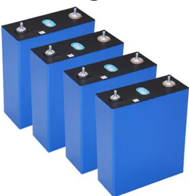Comparison of LFP / NMC technologies*

Lithium – Iron – Phosphate (LiFePO4): the chemistry of the industrial and automotive future
The LiFePO4 (LFP) chemistry particularly meets the needs of the industrial sector, thanks to a unique combination of high safety, significant longevity, and moderate energy requirements. It caters to a wide range of applications, from automation, robotics, logistics, construction, agriculture, boating, to electric vehicles, airport vehicles, aerial platforms, and special vehicles.
Exemplary safety and stability
LFP batteries are considered the safest and most stable on the current market. Available in large capacity formats suited to industrial needs, they avoid the multiplication of small cells in parallel, which can compromise system stability and safety.
Remarkable lifespan
Batteries using LFP chemistry offer lifecycles exceeding 3,500 cycles. Equipped with an efficient electronic management system (BMS), they can reach over 4,000 cycles, with future prospects going up to 6,000 cycles and beyond.
Note: a lifecycle does not mean the battery is unusable at the end of this period. Indeed, even after 3,500 cycles, a battery retains about 80% of its capacity, allowing for many secondary uses, particularly in stationary energy storage.
A major ecological advantage: the absence of cobalt
Unlike other lithium chemistries, the LFP battery is cobalt-free, a toxic material with a heavy environmental impact. This feature gives it a considerable ecological advantage, especially as many manufacturers are now trying to reduce cobalt usage.
Significant progress in energy density
A few years ago, the energy density of LFP batteries was low, around 100 Wh/kg, which limited their appeal. Today, this value has almost doubled, reaching 170 Wh/kg, sparking significant renewed interest, particularly in the automotive sector.
Medium-term prospects suggest a density reaching 220 to 230 Wh/kg, making LFP chemistry even more competitive.
Adoption by the automotive industry
This evolution explains why many car manufacturers are reintegrating LFP chemistry into their electric vehicles.
Among them:
Tesla, which already uses LFP in its 'standard range', prioritising safety and controlled cost,
BYD,
Volkswagen,
and many other major names in the automotive industry, who see strong future potential in LFP chemistry.
In Summary
| Attribute | Lithium-Iron-Phosphate (LFP) |
| Safety | Very High |
| Stability | Very Good |
| Lifespan | > 3,500 cycles, up to 6,000 expected |
| End-of-life residual capacity | ~ 80% |
| Absence of Cobalt | Yes |
| Energy Density | 170 Wh/kg today, 220-230 Wh/kg upcoming |
| Main Applications | Industry, robotics, electric vehicles, storage |
LFP in a few figures:
Nominal Voltage: 3.2 V
Energy Density: 177 Wh/kg
Volumetric Density: 384 Wh/l
Full Lifecycles: > 4,000
Discharge Rate: 1C to 3C (i.e., 1 to 3 times the nominal capacity)
+ Robustness, Safety, Cycles
-Mass

Nickel – Manganese – Cobalt (LiNixMnyCozO2): the dominant chemistry in the automotive industry
NMC chemistry remains the most used in the automotive sector today, thanks to its high energy density, allowing a large amount of energy to be stored with reduced weight and volume. This feature is essential for maximising the range of electric vehicles.
Main characteristics
Specific Energy: 220 – 240 Wh/kg, higher than other lithium chemistries.
Lifecycles: around 1,000 cycles under good charge/discharge conditions.
Cost: about 20% higher than LFP, mainly due to the presence of cobalt.
Variants of NMC chemistry
The NMC nomenclature indicates the percentage of Nickel, Manganese, and Cobalt in the cathode:
| Type | Composition (%) | Main characteristic |
| NMC 111 | Ni 33.3 – Mn 33.3 – Co 33.3 | Older version, less used |
| NMC 622 | Ni 60 – Mn 20 – Co 20 | Current standard version |
| NMC 811 | Ni 80 – Mn 10 – Co 10 | Newer, high energy density and reduced cost |
NMC 811, with high nickel content and low cobalt, allows for increased specific energy while reducing cost.
The evolution of NMC chemistry aims to reduce cobalt, a costly and difficult-to-extract element, while maintaining system stability and lifespan.
Innovation prospects
Some companies are already developing NMX cells, completely cobalt-free, paving the way for more economical and ecological batteries without compromising performance.
To summarise:
| Criterion | LiFePO4 (LFP) | LiNMC (NMC) |
| Nominal Cell Voltage | 3.2 V | 3.6 – 3.7 V |
| Energy Density (Wh/kg) | 170 – 177 Wh/kg | 220 – 240 Wh/kg |
| Volumetric Density (Wh/l) | 384 Wh/l | 600 – 650 Wh/l (variable depending on type) |
| Lifecycles | 3,500 – 4,000 cycles (up to 6,000 expected with BMS) | ~1,000 cycles |
| Recommended Depth of Discharge (DoD) | 70 – 90% | 80% |
| Discharge Rate | 1C to 3C | 1C to 2C |
| Safety | Very high, stable and non-flammable chemistry | Less stable than LFP, requires strict BMS protections |
| Cobalt | None | Present (progressive reduction depending on type: NMC 111, 622, 811) |
| Relative Cost | Lower | ~20% more expensive than LFP |
| Typical Applications | Industry, robotics, stationary storage, standard electric vehicles | Automotive, high-performance vehicles, applications requiring high energy density |
| Key Advantages | Long lifespan, safety, high residual capacity, lower cost, absence of cobalt | High energy density, low weight and volume, maximum vehicle range |
| Disadvantages | Lower energy density than NMC, limited charging below 0°C | Shorter lifespan, higher cost, presence of cobalt, lower safety |
*: The technical information presented in this article is provided for guidance only. It does not replace the official manuals of the manufacturers. Before any installation, handling or use, please consult the product documentation and follow the safety instructions. The site Torque.works cannot be held responsible for inappropriate use or incorrect interpretation of the information provided.